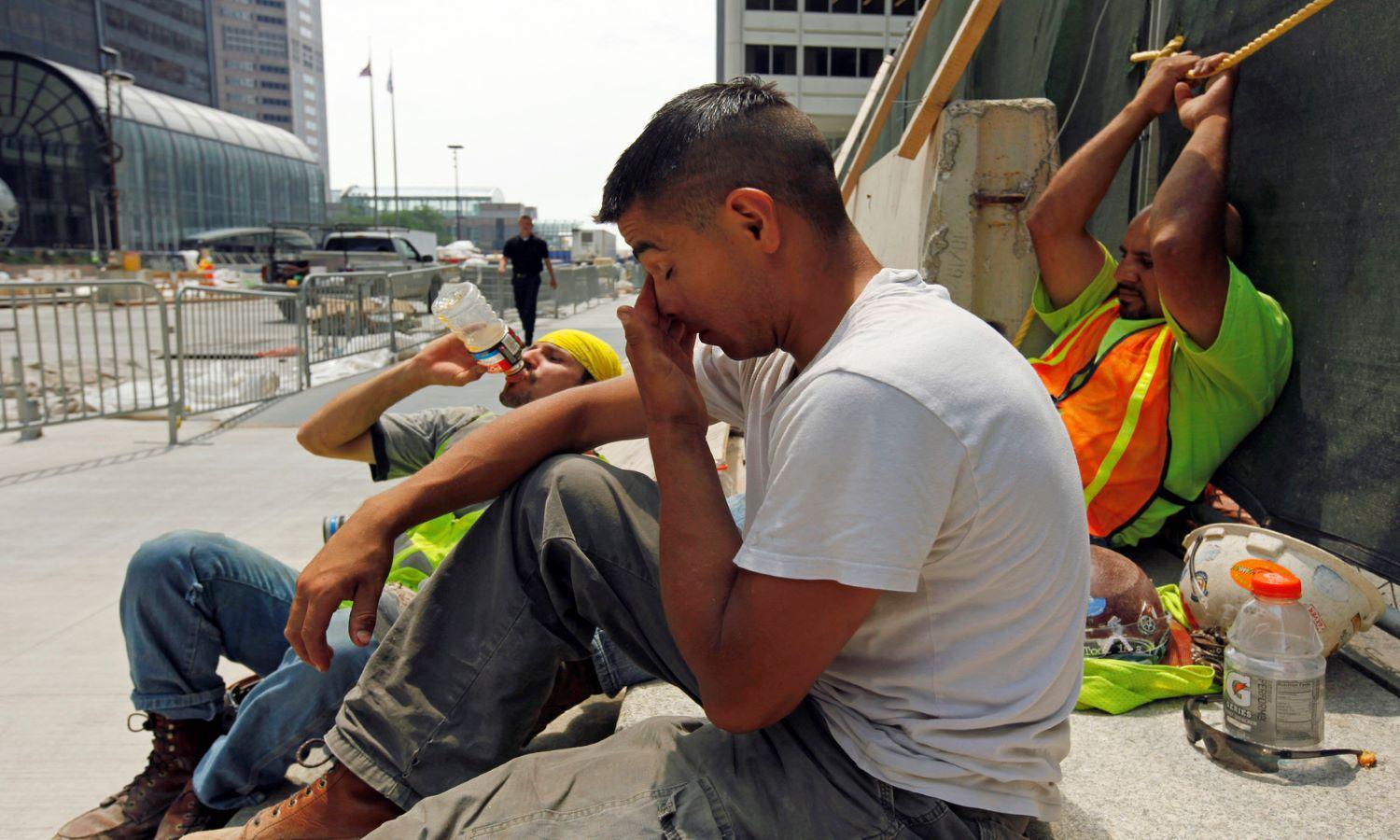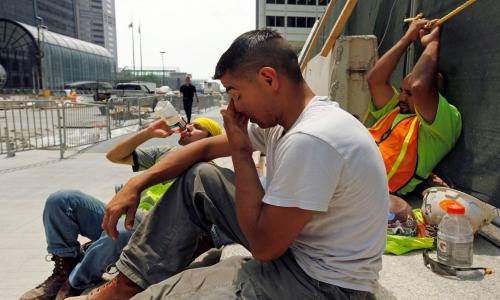Outdoor workers are encountering a deadly risk more frequently than ever before: intensifying extreme heat.
As climate change brings one record-heat decade after another, these workers will increasingly find themselves in an impossible situation—having to choose between risking their lives to go to work or their livelihoods to stay safe.
If we don’t take action on climate change, extreme heat would cause tens of millions of outdoor workers in the US to risk losing a collective $55.4 billion in earnings each year by midcentury, a peer-reviewed Union of Concerned Scientists (UCS) analysis shows.
Even with bold action to limit emissions, outdoor workers would face severe and rising risks from extreme heat.
With economic and legal systems that routinely discount these workers’ health and safety, those working in outdoor occupations have little or no recourse. Policymakers and employers must take action now to protect them.
Too Hot to Work
This is a condensed, online version of the report. Access to all figures and full report are available through download of the PDF.

The COVID-19 pandemic underscored weaknesses and stark variations in the protections available to workers in the United States. Across the nation, millions of people lost their jobs or were furloughed, their financial present and futures suddenly cast into doubt. And while those in some types of jobs could reduce their exposure to COVID-19 by working from home, workers in many outdoor occupations were deemed essential. In planting and harvesting food to fill our plates, responding to community emergencies, caring for our roads and rails, and delivering supplies that shuttered stores could not provide, they risked infection, illness, and even death—their own, or their families’—as they performed their daily work.
Yet the novel coronavirus is only the latest addition to a long list of on-the-job hazards confronting outdoor workers. Each summer, the roughly 32 million outdoor workers across the United States—from construction workers to farmworkers to emergency responders—regularly face a brutal choice: risk their health by enduring dangerous exposure to heat or risk their jobs by staying home.
Outdoor workers in the United States have up to 35 times the risk of dying from heat exposure than does the general population (Gubernot, Anderson, and Hunting 2015). With climate change making days of extreme heat more frequent and more intense, the number of hours and days when outdoor work is unsafe will increase further unless employees and employers are willing and able to adapt to changing conditions. Even with adaptations to climate change, outdoor workers could be forced to choose between their health and a paycheck.
Outdoor workers’ earnings at risk annually by midcentury
Additionally, differences in heat exposure between outdoor workers and the rest of the population deepen existing social, economic, and health inequalities. Given that Black and Hispanic/Latino workers are disproportionately represented in many outdoor occupations, earnings losses for outdoor workers due to climate change could exacerbate inequities in health outcomes, poverty rates, and economic mobility, all of which result from centuries of systemic racism.
This Union of Concerned Scientists (UCS) report on projected losses in safe workdays and projected earnings at risk combines county-level projections of dangerously hot days from our 2019 Killer Heat analysis with county-level US Census data on the number of people employed in predominantly outdoor occupations, the type of work they do, and how much they earn (Dahl et al. 2019a; Dahl 2019b; US Census Bureau 2018). County by county, we calculated workdays and earnings at risk in the future from climate change, using Centers for Disease Control and Prevention (CDC) recommendations on reducing outdoor work based on temperature and humidity conditions.
Our analysis finds that by midcentury, given slow or no action to reduce global heat-trapping emissions, the increased intensity, frequency, and geographic extent of extreme heat would cause a three- to fourfold increase in the exposure of outdoor workers to days with a heat index—or “feels like” temperature—above 100°F, the point at which the CDC recommends that work hours begin to be reduced.
Depending on the trajectory of future heat-trapping emissions, $39.3 to $55.4 billion in outdoor workers’ earnings would be at risk annually by midcentury, with implications for workers, employers, and the broader economy. With no action to reduce global emissions, more than 7.1 million US workers would see 10 percent or more of their earnings at risk annually due to extreme heat, and losses would only grow as warming continues beyond midcentury. With slow action—rather than no action—to reduce emissions, the potential losses would be dramatically lower but still far too high: nearly a quarter million workers would be at risk of such earnings losses.
Who Works Outdoors?
The UCS analysis used census data to quantify the number of people employed in occupational categories for which two-thirds or more of jobs require outdoor work (Table 1) (BLS n.d.).
Using these data, UCS identified the incomes and demographic profiles of outdoor workers. Men made up approximately 83 percent of the workers in the analysis. Black and Hispanic/Latinos were disproportionately represented in the outdoor workforce: more than 40 percent of outdoor workers identified as either Black or Hispanic/Latino despite comprising about 32 percent of the general population (US Census Bureau 2018; BLS n.d.).
Typical earnings for some outdoor occupations (e.g., protective service) were above the median income nationally. However, many other types of outdoor workers earned less. For example, building and grounds cleaning and maintenance workers earned on average 43 percent less than the US workforce as a whole.
Exposed and Unprotected
Even aside from climate change, current laws and regulations regarding heat exposure are inadequate for protecting outdoor workers. While the impacts of heat on health depend on many factors, the Occupational Safety and Health Administration (OSHA) recommends that employers implement precautions when the heat index exceeds 90°F (OSHA n.d.). The CDC further recommends reducing work schedules as “adjusted temperatures” (roughly equivalent to the heat index) rise to between 100°F and 108°F. Above 108°F, outdoor work would need to be cancelled or rescheduled because the risks to health are so grave (Jacklitsch et al. 2016).
However, these are just recommendations in most states, meaning they are voluntary. Only California and Washington State have set heat-related protective standards for outdoor workers that are enforceable under state or federal law. Additional factors—such as language barriers, gaps in health insurance, and concerns about immigration status—compound the lack of protective standards, leaving workers experiencing heat-related injuries or on-the-job illnesses with little to no legal recourse.
Findings and Implications
Exposure to Extreme Heat Grows Nationwide
With slow or no action to reduce global emissions and assuming no change in the number of outdoor workers, the exposure of the nation’s outdoor workers to days with a heat index above 100°F would increase three- or fourfold by midcentury (Table 2).
To calculate the increase for each county, UCS multiplied the number of days with a heat index above 100°F by the number of outdoor workers, resulting in county-by-county figures for “person-days per year.” The next three decades—the period over which our midcentury projections unfold—will represent nearly the entire career of a young adult now entering the workforce. In other words, these workers are expected to face increasingly dangerous conditions, as well as increasingly heavy tolls on their earnings, over the course of their working lives. Moreover, because Black and Hispanic/Latino workers disproportionately comprise many US outdoor occupations, we forecast they will be disproportionately exposed to extreme heat at work. For example, in California, where more than 90 percent of farmworkers are Hispanic/Latino, there would be, on average, 17 more days per year with a heat index above 100°F by midcentury if no action is taken on climate change.
For many outdoor workers and their employers, increasingly frequent instances of extreme heat would substantially decrease the number of safe workdays per year. The analysis finds that nearly 3 million outdoor workers in the United States already experience the equivalent of seven or more unsafe workdays per year due to extreme heat. Relatively few of the workers are guaranteed protections in the face of those unsafe working conditions today. In an average year by midcentury, 14.0 million outdoor workers would experience that much unsafe work time—or more—if we take slow action to reduce global emissions. With no action to reduce emissions, that would increase to 18.4 million outdoor workers and affect more than 60 percent of all counties in the contiguous United States. This unsafe or lost work time could translate into staggering health concerns and sizeable earnings losses for the workers, substantial productivity losses for employers, and potential disruptions in the products and services provided to families and communities by outdoor workers.
Earnings losses would compound existing income inequalities for many communities of color. In Nevada, for example, the nearly one-third of Black who are employed in outdoor work would be at risk of losing significant income as a result of extreme heat.
Heat Endangers Both Urban and Rural Outdoor Workers
The increased exposure of outdoor workers to extreme heat would affect both urban and rural counties (Figure 1). Owing to their larger populations, urban counties typically have more outdoor workers than do rural counties, which means more people exposed to extreme heat. The counties projected to have the highest number of workers exposed to extreme heat by midcentury include some of the nation’s largest cities, such as Chicago, Houston, Miami, and Phoenix.
On the other hand, outdoor workers comprise a larger proportion of the rural workforce. With no climate action, more than half of the counties with a high proportion of outdoor workers (defined as counties in which more than 25 percent of people work outdoors) would experience 30 to 90 days per year with a heat index above 100°F (Figure 2). The hardest-hit counties in terms of the number of days above 100°F at midcentury with no climate action and the highest proportion of outdoor workers include Hendry County, Florida, and Kenedy County, Texas—places where more than half of residents identify as Hispanic/Latino.
Extreme Heat Threatens Both Earnings and the Broader Economy
Increasingly frequent extreme heat would heavily endanger the health and livelihoods of outdoor workers. By midcentury, between 4.1 million (in a slow-action scenario on curbing emissions) and 7.1 million (in a no-action scenario) workers nationwide would see 10 percent or more of their earnings at risk annually due to extreme heat. Black and Hispanic/Latino workers, who together hold a disproportionately high number of jobs in many outdoor occupations, would face an estimated $5.2 to $7.5 billion and $11.2 to $16.1 billion, respectively, in earnings at risk annually; the ranges represent findings from the slow-action and no-action scenarios.
The income losses due to extreme heat would add to the economic burden on households already stretched thin. For example, the nation’s 7.6 million construction and extraction workers—one-third of whom are Hispanic/Latino—would on average risk losing nearly $1,900 in income annually by midcentury as a result of extreme heat if no action is taken on climate change; approximately one quarter of these workers would risk losing $3,000 or more each year. Significantly, even before the economic fallout from COVID-19, nearly 80 percent of all US workers were living paycheck to paycheck (CareerBuilder 2017).
At the community level, reduced earnings for outdoor workers could translate into reduced local income-tax revenue as well as increased demand for public services dependent on that revenue (Figure 3). Moreover, a loss in the amount of time outdoor workers can safely perform their jobs would potentially disrupt the essential services they provide, from building maintenance and construction to law enforcement and the harvesting of food crops.
Outdoor workers, who are disproportionately Black and Latino, have a much higher risk of dying from heat exposure than the general population.
Protecting Outdoor Workers from Extreme Heat
Limiting climate change, and, in turn, extreme heat, is essential to protecting outdoor workers. To this end, the United States must make robust contributions to global climate action, including implementing just and equitable solutions that fulfill its commitments to, at a minimum, reduce “its net greenhouse gas emissions by 50–52 percent below 2005 levels in 2030,” as well as to achieve net-zero emissions no later than 2050. Policies and investments to advance clean electricity, energy efficiency, zero-emission vehicles, mass transit, electrification of buildings and industrial processes, and healthy soils and forests can help create jobs and jumpstart economic recovery, while lowering emissions and delivering public health benefits.
However, even with bold action to limit emissions, outdoor workers face severe and rising risks from extreme heat, which is why workers in many occupations have long advocated for greater on-the-job protections. Policymakers and employers need to act now to establish and implement those protections. And public policy must explicitly address the social determinants of health—including long-standing racism—that put Black, Hispanic/Latino, and low-wage workers at heightened risk.
As a result, Congress should:
-
Enact the Asunción Valdivia Heat Illness and Prevention Act of 2021 (H.R. 2193/S. 1068), which directs the US secretary of labor to develop and set a mandatory heat health protective standard for workers, enforceable by OSHA, within 42 months. This standard would save lives by requiring commonsense measures like providing adequate hydration, shade, rest breaks, and acclimatization periods.
-
As part of the heat standard, OSHA and the National Institute for Occupational Safety and Health (NIOSH) should work together to recommend heat-safety plans for outdoor workers. The recommendations should consider a number of risk factors, including the co-occurrence of extreme heat with high levels of air pollution (specifically, ground-level ozone and particulate matter); exposure to toxic pesticides; elevated risks to certain populations; and the urban heat island effect, which causes cities to be significantly hotter than surrounding areas (Schnell and Prather 2017; Ferguson et al. 2019), as well as the cumulative effects of exposure to combinations of these hazards.
-
OSHA and NIOSH should work in coordination to establish a task force that makes recommendations for detecting and preventing heat-related illnesses, tailored to specific sectors, workforce populations, and regions. Its mission should include tracking and recording the health impacts of heat waves on workers in real time and using those findings to inform its recommendations on how to limit future adverse health outcomes.
-
Direct the US Department of Agriculture’s Climate Hubs to establish regional programs dedicated to research on extreme-heat science and health impacts on agricultural workers, as well as to develop policies and best practices to address these challenges.
In addition to NIOSH and OSHA recommendations for heat-safety plans, the federal government and states should require employers to:
-
Implement comprehensive, science-informed workplace heat-safety plans, developed based on NIOSH guidance and in consultation with their labor forces and health and workplace safety experts, and enforced by OSHA;
-
Comply with monitoring and reporting requirements, as established by OSHA;
-
Invest in multilingual training—for supervisors and workers—on recognizing and responding to the dangers of extreme heat; and
-
Invest in protective clothing and equipment, wearable heat sensors, and heat-assessment tools. If possible, employers should shift work to cooler time periods.
Comprehensive and just heat-safety policies must protect the health, well-being, and safety of outdoor workers, many of whom face longstanding inequities due to race, ethnicity, class, or immigration status. These policies must include:
-
Guarantees of fair wages and benefits and safe working conditions;
-
Access to affordable medical care and safe, affordable, cool housing; and
-
Legal safeguards to protect the rights of workers regardless of immigration status, including when reporting workplace safety violations.
Additionally, policies and investments are needed to support just transitions when climate change brings about shifts in outdoor work. Supporting “high-road” labor standards,13 protecting collective bargaining rights, and creating pathways to legal immigration status are all vital for the health and welfare of outdoor workers.
Conclusion
As the United States rebounds from the COVID-19 pandemic, the nation must seek a firm footing that simultaneously fosters economic recovery and moves toward a thriving, sustainable future—a future resilient to inevitable shocks like pandemics and increasingly extreme climate disasters. That resilience will be essential for the tens of millions of outdoor workers who build and maintain the transportation, energy, food, communications, and other essential systems we all need.
A climate-altered future may also necessitate radical changes in outdoor work, such as increased automation, adjustments in where and when certain types of work take place, and structural changes in the economy. At the same time, pandemic-related changes such as the increased reliance on food and product-delivery services could expand the number of people whose jobs require them to be outdoors—and therefore the number of workers exposed to extreme heat. Without attention to justice and equity, such changes will fall especially hard on the working class.
Today, despite decades of consistent calls for greater on-the-job protections, many outdoor workers face economic and legal systems that discount their lives and safety. If we fail to act or act too slowly to limit future warming, the next generation of outdoor workers could spend the prime years of their working lives toiling in heat that compromises their health and their livelihoods. By bringing our greatest ambitions and bold policies to the task of reducing carbon emissions, and by enacting policies that treat outdoor workers as the essential and valuable members of society they are, we can create a future that is safer, healthier, and more livable for all.
Assumptions, Limitations, and Caveats
This UCS analysis assumes no changes in the size of the US population, the number of outdoor workers, or where outdoor work takes place. Further, it does not consider the potential to shift outdoor work to cooler nighttime hours or institute other potential worker protections; this may have led to overestimates of the number of workdays at risk. Also not considered are such adaptations to heat as innovations in clothing technology. Due to limitations in the underlying climate model data used in our analysis, the heat-index projections do not explicitly include the urban heat-island effect.
The data on outdoor workers exclude some occupations for which outdoor work is required, for example members of the military and mail carriers, as well as those for which outdoor work had not been critical prior to the COVID pandemic. At the same time, some occupational categories may include jobs for which some work takes place indoors. In addition, it is unclear the degree to which census data reflect migrant and undocumented workers. When calculating exposure, the UCS analysis looks only at the warm season (April through October) and does not consider job seasonality. When calculating workdays and earnings at risk, we assume that workers are conducting moderately physical work and are exposed to the daily maximum heat index for four hours per workday; this may overestimate or underestimate exposure depending on the workday. We also assume that worker earnings are evenly distributed throughout the year, reflect a 40-hour work week, and are unpaid when outdoor work cannot be performed safely. The calculations of wages at risk for particular race and ethnic groups use the median occupational category wages for all race and ethnic groups combined.
This is a condensed, online version of the report. Access to all figures and full report are available through download of the PDF.
Downloads
Citation
Dahl, Kristina, Rachel Licker. 2021. Too Hot to Work: Assessing the Threats Climate Change Poses to Outdoor Workers. Cambridge, MA: Union of Concerned Scientists. https://doi.org/10.47923/2021.14236









